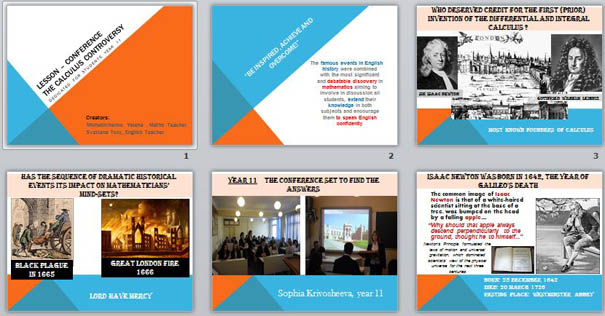
Lesson – Conference The Calculus Controversy
Dedicated for students year 11
Creators:
Mikhailichenko Yelena , Maths Teacher
Svetlana Tsoy, English Teacher

“ Be Inspired, Achieve and overcome!”
The famous events in English history were combined with the most significant and debatable discovery in mathematics aiming to involve in discussion all students, extend their knowledge in both subjects and encourage them to speak English confidently

Who deserved credit for the first (prior) invention of the differential and integral calculus ?
Sir Isaac Newton
Gottfried Wilhelm Leibniz
Most known founders of calculus

has the sequence of dramatic historical events its impact on mathematicians’ mind-sets?
Great London Fire 1666
Black Plague in 1665
Lord Have Mercy

Year 11 The conference set to find the answers
Sophia Krivosheeva, year 11

Isaac Newton was born in 1642, the year of Galileo's death
The common image of Isaac Newton is that of a white-haired scientist sitting at the base of a tree, was bumped on the head by a falling apple …
“ Why should that apple always descend perpendicularly to the ground, thought he to himself...”
Newton's Principia formulated the laws of motion and universal gravitation, which dominated scientists' view of the physical universe for the next three centuries
Born: 25 December 1642
Died: 20 March 1726
Resting place: Westminster Abbey

This was the worst outbreak of plague in England
London lost roughly 15% of its population. While 68,596 deaths were recorded in the city, the true number was probably over 100,000
Rats carried the fleas that caused the plague. They were attracted by city streets filled with rubbish and waste, especially in the poorest areas .
Newton later recalled: 'All this was in the two plague years of 1665 and 1666, for in those days I was in my prime of age for invention, and minded mathematics and philosophy more than at any time since.'
Cambridge was closed for the next two years, Newton returned to Woolsthorpe. There, in the following 18 months, he created Calculus . However, he did not publish it. This was an enormous mistake.

The Great Fire of London started on 2 September 1666
The Great Fire of London swept through the city, devastating many buildings including 13,200 houses, 87 parish churches , The Royal Exchange and Guildhall. St. Paul’s Cathedral, built during the middle ages.
It started in the baker, Thomas Faynor’s shop and spread rapidly, helped by a strong wind from the East.
Firefighting at the time was very basic and there was little skill or knowledge involved. They used leather buckets, axes and water squirts which had little effect on the fire.
The new city was planned by Christopher Wren and rebuilt using stone over the following 30 years

Expert’s point of view on Great Fire, London
“ There were some benefits of the fire…
One of these was that the black plague which had killed many people was eliminated by the burning down of diseased, rat-infected properties…
In fact, it stopped the black death ”
Svetlana Tsoy, English teacher

Expert’s point of view Newton versus Leibniz
It appears that Newton not only went much further in exploring the applications of calculus than Leibniz did, but he also ventured down a different road.
Leibniz and Newton had very different views of calculus in that Newton’s was based on limits and concrete reality , while Leibniz focused more on the infinite and the abstract .

Gottfried Wilhelm von Leibniz
Leibniz discovered “his” calculus in Paris between 1673 and 1676 .
Newton first described his methods, formulas and concepts of calculus, including his binomial theorem, fluxions and tangents, in letters he wrote to Leibniz .
However an examination of Leibniz' unpublished manuscripts provided evidence that despite his correspondence with Newton , he had come to his own conclusions about calculus already.
In fact, the delayed publication of Newton’s findings caused the entire controversy.
Born: 1 July 1646, Leipzig, Germany
Died: 14 November 1716, Hanover, Germany
Leibniz published the first account of differential calculus in 1684 and then published the explanation of integral calculus in 1686

Newton published his findings only in 1687, but…
E vidence shows that Newton discovered his theories of fluxional calculus in 1665 and 1666 , after having studied the work of other mathematicians such as Barrow and Wallis
E vidence also shows that Newton was the first to establish the general method called the "theory of fluxions" was the first to state the fundamental theorem of calculus and was also the first to explore applications of both integration and differentiation in a single work.
Isaak Barrow
1630-1677
Matter of “national pride”, England refused to teach anything but Newton’s discoveries of geometrical and fluxional methods for over a century…

Royal Society verdict
In 1715 , just a year before Leibniz death, the Royal Society handed down their verdict crediting Sir Isaac Newton with the discovery of calculus.
It was also stated that Leibniz was guilty of plagiarism.
It later became known that these accusations were false, and both men were then given credit, but not until after Leibniz had already died.
No matter who actually discovered calculus first, both Newton and Leibniz made great contributions to the advancement of mathematical processes, and both deserve credit for that

At the end of conference students were asked to complete a Quiz
18 students achieved A+
(outstanding)
2 students achieved A
(good)
Students’ outcome regarding lesson:
“ Innovative, Inspirational, Incredible…”


 Получите свидетельство
Получите свидетельство Вход
Вход


























 Презентация к уроку математики "Интегральное и дифференциальное исчисления в работах английских математиков" (4.76 MB)
Презентация к уроку математики "Интегральное и дифференциальное исчисления в работах английских математиков" (4.76 MB)
 0
0 321
321 30
30 Нравится
0
Нравится
0


